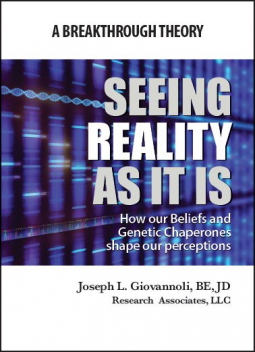
Seeing Reality As It Is
How our Beliefs and Genetic Chaperones shape our perceptions
by Joseph L. Giovannoli
This title was previously available on NetGalley and is now archived.
Send NetGalley books directly to your Kindle or Kindle app
1
To read on a Kindle or Kindle app, please add kindle@netgalley.com as an approved email address to receive files in your Amazon account. Click here for step-by-step instructions.
2
Also find your Kindle email address within your Amazon account, and enter it here.
Pub Date Nov 19 2019 | Archive Date Apr 15 2020
Talking about this book? Use #RealityAsItIs #NetGalley. More hashtag tips!
Description
Seeing Reality As It Is examines the question - If there is only one reality, why can't we agree on what it is? If we understand why we each perceive reality in our own way, we are more likely to make progress in dealing with political polarization and climate change. An example of perceiving reality in our own way is seen in comparing the color perceptions of normally sighted and colorblind people. Due to genetic differences in their ability to sense color, they take away different perceptions from a common color experience. In much the same way, we are born with various perceptive differences that cause each of us to “see” the same reality in different ways. These differences result from countless ancestral trial and error survival experiences. Today, perceptive differences we inherit include variations in our biases, levels of thought-altering neurochemicals, and slightly different brain circuits that influence how we think by creating fictitious perceptions. For example, ego enhancing biases cause us to think we are more capable than we are. The particular combination of survival enhancing biases and brain traits we each inherit was coined by the author as our "genetic chaperone”. As with colorblindness, we are unaware that we have a genetic chaperone until it is brought to our attention. Given the variations in our genetic chaperones, we each “see” different survival-enhancing versions of reality instead of perceiving reality as it is. In essence, our chaperones aid our survival, not by causing us to understand reality, but by creating fictitious perceptions that cause us to respond “as if” we understand reality. An inadvertent consequence of perceiving reality in this way is that our beliefs are shaped by the false perceptions of our genetic chaperones and not by reality as it is. What is more, our false beliefs can go on to distort our future beliefs because we have a brain trait that conforms new beliefs to fit the narrative of our existing beliefs. In other words, our beliefs alter our perceptions. Recently, social media data–gathering has complicated another problem involving our genetic chaperones. Data that describes our genetic chaperone profiles is being used by “chaperone hackers” (propagandists) to manipulate how we see reality by fabricating very “personalized” fake news, social media events, and so on. Reaching agreement on what reality is can be daunting given the fictitious perceptions our genetic chaperones create. It follows that addressing problems that divide us and threaten our future might begin with understanding the nature of our genetic chaperones and how to minimize their influence.
Advance Praise
KIRKUS
REVIEWS
TITLE INFORMATION
SEEING REALITY AS IT IS
Joseph L. Giovannoli
Research Associates, LLC (145 pp.)
BOOK REVIEW
Giovannoli (The Biology of Belief, 2000) offers an explanation for the origin of diversity of human belief systems in this work of anthropology.
Why do we all perceive reality so differently? Why does a scientist see such a different world when she gets up in the morning than a theologian might see---or even another scientist? “Our history appears to be a series of ongoing disagreements over what is real or true,” observes Giovannoli at the beginning of this work, which seeks to synthesize the finding of many separate fields of study---genetics, neuroscience, psychology, history, cosmology, and more---in order to put forth a cohesive theory for our individualized perceptions. He argues that our brains developed not to perceive the world accurately, but rather to help us survive, which isn’t at all the same thing. While this reality-shaping instinct---Giovannoli calls it our “chaperone”---aided our ancestors, it has proven in more recent millennia to be highly susceptible to manipulation. The author theorizes how such a function arose in the first place, how that function operates in our brains, how a belief system comes to be formed, and the ways that culture can be transmitted across generations or groups. Giovannoli describes what he terms “psychogenes,” units of belief that spread due to their perceived value. By taking this new approach to belief, the author attempts to show not only how people can see things so differently, but why they shouldn’t allow that fact to make them enemies. Giovannoli’s prose is technical, yet accessible, and he does an admirable job explaining his theories to the general reader, as when he demonstrates how psychogenes moved from ancient Greece to Rome: “Within about one hundred years after conquering Greece, Rome had been influenced significantly by the experience. As the Roman State assimilated its Greek gifts, Roman psychogenes evolved into Greco-Roman psychogenes.” Giovannoli admits to being a generalist, and experts in various fields may take issues with part or all of his theory. Even so, there is much here that is deeply fascinating and may prove to be very persuasive---depending on the leniency of the reader’s chaperone, of course.
An original, highly intriguing theory on how and why beliefs are formed, inherited, and transmitted.
Available Editions
| EDITION | Ebook |
| ISBN | 9781733339308 |
| PRICE | 8.95 |
Average rating from 5 members
Featured Reviews
 Mukesh G, Reviewer
Mukesh G, Reviewer
i got a review digital copy of this book. This book is out at the right time. All of us need to read this and understand how our belief systems work and how they can be and are being manipulated by everyone around.
All in all, a great read! Most recommended!!
Readers who liked this book also liked:
Leland Vittert
Biographies & Memoirs, Nonfiction (Adult), Parenting, Families, Relationships
Carol C. Darr
Business, Leadership, Finance, Nonfiction (Adult), Politics & Current Affairs
Melissa Bernstein
Business, Leadership, Finance, Religion & Spirituality, Self-Help
Patrick Riccards
Business, Leadership, Finance, Nonfiction (Adult), Politics & Current Affairs
Ann-Margaret Carrozza
Business, Leadership, Finance, Parenting, Families, Relationships, Professional & Technical














